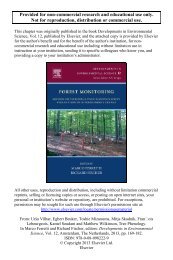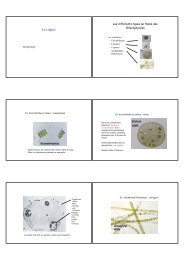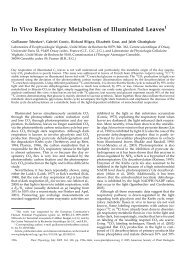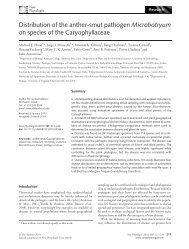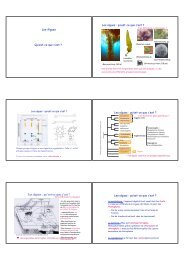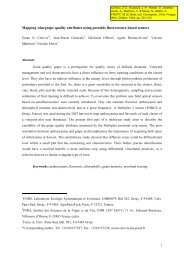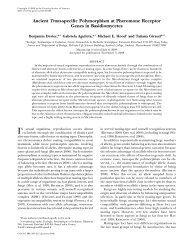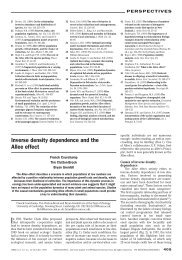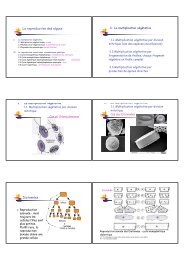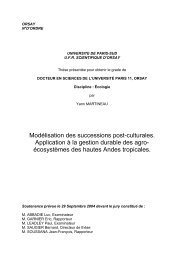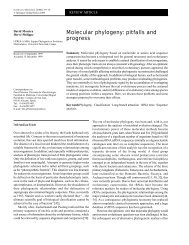- Page 1 and 2:
N° d’ordre : UNIVERSITE PARIS-SU
- Page 3 and 4:
Remerciements Je remercie tout d’
- Page 5 and 6:
Sommaire __________________________
- Page 7 and 8:
Sommaire __________________________
- Page 9 and 10:
Introduction ______________________
- Page 11 and 12:
Introduction ______________________
- Page 13 and 14:
Introduction ______________________
- Page 15 and 16:
Introduction ______________________
- Page 17 and 18:
Introduction ______________________
- Page 19 and 20:
Introduction ______________________
- Page 21 and 22:
I - La tortue à tempes rouges, un
- Page 23 and 24:
I - La tortue à tempes rouges, un
- Page 25 and 26:
I - La tortue à tempes rouges, un
- Page 27 and 28:
I - La tortue à tempes rouges, un
- Page 29 and 30:
I - La tortue à tempes rouges, un
- Page 31 and 32:
I - La tortue à tempes rouges, un
- Page 33 and 34:
I - La tortue à tempes rouges, un
- Page 35 and 36:
I - La tortue à tempes rouges, un
- Page 37 and 38:
II - Les tortues à tempes rouges,
- Page 39 and 40:
II - Les tortues à tempes rouges,
- Page 41 and 42:
II - Les tortues à tempes rouges,
- Page 43 and 44:
II - Les tortues à tempes rouges,
- Page 45 and 46:
II - Les tortues à tempes rouges,
- Page 47 and 48:
II - Les tortues à tempes rouges,
- Page 49 and 50:
II - Les tortues à tempes rouges,
- Page 51 and 52:
II - Les tortues à tempes rouges,
- Page 53 and 54:
II - Les tortues à tempes rouges,
- Page 55 and 56:
II - Les tortues à tempes rouges,
- Page 57 and 58:
II - Les tortues à tempes rouges,
- Page 59 and 60:
II - Les tortues à tempes rouges,
- Page 61 and 62:
II - Les tortues à tempes rouges,
- Page 63 and 64:
II - Les tortues à tempes rouges,
- Page 65 and 66:
II - Les tortues à tempes rouges,
- Page 67 and 68:
II - Les tortues à tempes rouges,
- Page 69 and 70:
II - Les tortues à tempes rouges,
- Page 71 and 72:
II - Les tortues à tempes rouges,
- Page 73 and 74:
II - Les tortues à tempes rouges,
- Page 75 and 76:
II - Les tortues à tempes rouges,
- Page 77 and 78:
II - Les tortues à tempes rouges,
- Page 79 and 80:
II - Les tortues à tempes rouges,
- Page 81 and 82:
II - Les tortues à tempes rouges,
- Page 83 and 84:
III - Etudes expérimentales des pr
- Page 85 and 86:
III - Etudes expérimentales des pr
- Page 87 and 88:
III - Etudes expérimentales des pr
- Page 89 and 90:
III - Etudes expérimentales des pr
- Page 91 and 92:
III - Etudes expérimentales des pr
- Page 93 and 94:
III - Etudes expérimentales des pr
- Page 95 and 96:
III - Etudes expérimentales des pr
- Page 97 and 98:
III - Etudes expérimentales des pr
- Page 99 and 100:
III - Etudes expérimentales des pr
- Page 101 and 102:
III - Etudes expérimentales des pr
- Page 103 and 104:
III - Etudes expérimentales des pr
- Page 105 and 106:
III - Etudes expérimentales des pr
- Page 107 and 108:
III - Etudes expérimentales des pr
- Page 109 and 110:
III - Etudes expérimentales des pr
- Page 111 and 112:
III - Etudes expérimentales des pr
- Page 113 and 114:
III - Etudes expérimentales des pr
- Page 115 and 116:
Conclusion & Perspectives _________
- Page 117 and 118:
Conclusion & Perspectives _________
- Page 119 and 120:
Conclusion & Perspectives _________
- Page 121 and 122:
Conclusion & Perspectives _________
- Page 123 and 124:
Bibliographie _____________________
- Page 125 and 126:
Bibliographie _____________________
- Page 127 and 128:
Bibliographie _____________________
- Page 129 and 130:
Bibliographie _____________________
- Page 131 and 132:
Bibliographie _____________________
- Page 133 and 134:
Bibliographie _____________________
- Page 135 and 136:
Bibliographie _____________________
- Page 137 and 138:
Bibliographie _____________________
- Page 139 and 140:
Bibliographie _____________________
- Page 141 and 142:
Bibliographie _____________________
- Page 143 and 144:
Bibliographie _____________________
- Page 145 and 146:
Bibliographie _____________________
- Page 147 and 148:
Bibliographie _____________________
- Page 149 and 150:
Bibliographie _____________________
- Page 151 and 152:
TABLE DES ANNEXES A. Supplementary
- Page 153 and 154:
Annexe A __________________________
- Page 155 and 156:
Annexe A __________________________
- Page 157 and 158:
Annexe A __________________________
- Page 159 and 160:
Annexe A __________________________
- Page 161 and 162:
Annexe I __________________________
- Page 163 and 164:
Annexe I __________________________
- Page 165 and 166:
Annexe I __________________________
- Page 167 and 168:
Annexe I __________________________
- Page 169 and 170:
Annexe I __________________________
- Page 171 and 172:
ANNEXE II ASSESSMENT OF PATTERNS OF
- Page 173 and 174:
Annexe II _________________________
- Page 175 and 176:
Annexe II _________________________
- Page 177 and 178:
Annexe II _________________________
- Page 179 and 180: Annexe II _________________________
- Page 181 and 182: Annexe III ________________________
- Page 183 and 184: Annexe III ________________________
- Page 185 and 186: Annexe III ________________________
- Page 187 and 188: Annexe III ________________________
- Page 189 and 190: Annexe III ________________________
- Page 191 and 192: Annexe III ________________________
- Page 193 and 194: Annexe III ________________________
- Page 195 and 196: Annexe III ________________________
- Page 197 and 198: Annexe III ________________________
- Page 199 and 200: Annexe III ________________________
- Page 201 and 202: Annexe III ________________________
- Page 203 and 204: Annexe III ________________________
- Page 205 and 206: Annexe III ________________________
- Page 207 and 208: Annexe III ________________________
- Page 209 and 210: Annexe III ________________________
- Page 211 and 212: Annexe III ________________________
- Page 213 and 214: ANNEXE IV THE RIGHTING RESPONSE AS
- Page 215 and 216: Annexe IV _________________________
- Page 217 and 218: Annexe IV _________________________
- Page 219 and 220: Annexe IV _________________________
- Page 221 and 222: Annexe IV _________________________
- Page 223 and 224: Annexe IV _________________________
- Page 225 and 226: Annexe IV _________________________
- Page 227 and 228: Annexe IV _________________________
- Page 229: Annexe IV _________________________
- Page 233 and 234: Annexe IV _________________________
- Page 235 and 236: Annexe IV _________________________
- Page 237 and 238: Annexe IV _________________________
- Page 239 and 240: Annexe IV _________________________
- Page 241 and 242: Annexe IV _________________________
- Page 243 and 244: TURTLE, AN EXOTIC AND INTRODUCED SP



